Discover 35 hidden attractions, cool sights, and unusual things to do in Newcastle upon Tyne (United Kingdom). Don't miss out on these must-see attractions: Northumberland Street, Great North Museum: Hancock, and Centre for Life. Also, be sure to include Great North Museum in your itinerary.
Below, you can find the list of the most amazing places you should visit in Newcastle upon Tyne (England).
Table of Contents
Northumberland Street

Street in Newcastle upon Tyne, England. Northumberland Street is a major shopping street in the city of Newcastle upon Tyne, in the North East of England. It is home to a wide range of different retailers, banks and cafes, and in terms of rental per square foot, Northumberland Street is the most expensive location in the UK outside London to own a shop. There are currently over 51 retailers including pubs on Newcastle's Northumberland Street.[1]
Address: Northumberland St, NE1 Newcastle upon Tyne
Great North Museum: Hancock
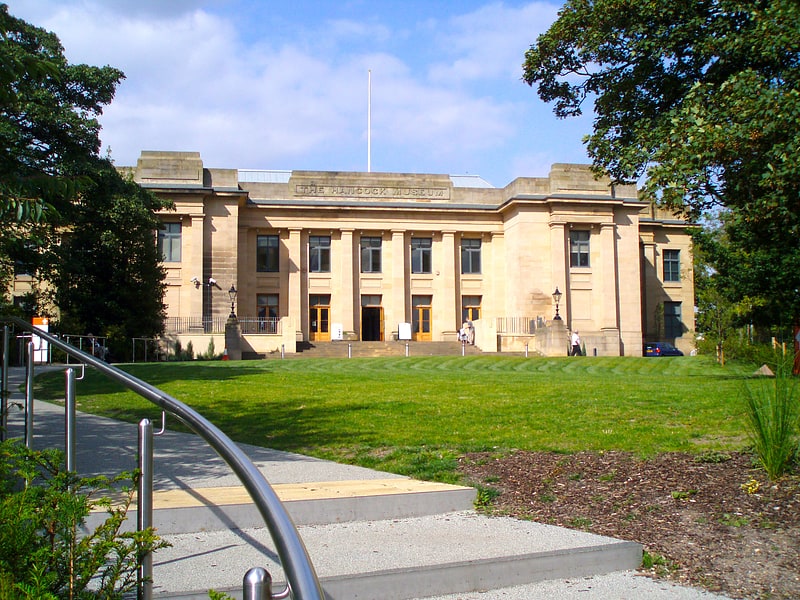
Museum in Newcastle upon Tyne, England. The Great North Museum: Hancock is a museum of natural history and ancient civilisations in Newcastle upon Tyne, England.
The museum was established in 1884 and was formerly known as the Hancock Museum. In 2006 it merged with Newcastle University's Museum of Antiquities and Shefton Museum to form the Great North Museum. The museum reopened as the Great North Museum: Hancock in May 2009 following a major extension and refurbishment of the original Victorian building. The museum and most of its collections are owned by the Natural History Society of Northumbria, and it is managed by Tyne & Wear Archives & Museums on behalf of Newcastle University.[2]
Address: Barras Bridge, NE2 4PT Newcastle upon Tyne
Centre for Life
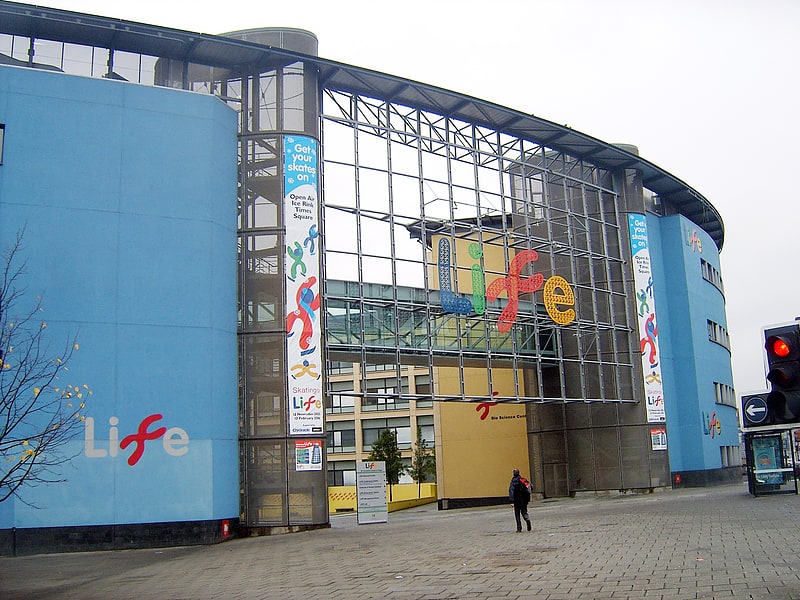
Science museum in Newcastle upon Tyne, England. The Centre for Life is a science village in Newcastle upon Tyne where scientists, clinicians, educationalists and business people work to promote the advancement of the life sciences. The centre is a registered charity, governed by a board of trustees, which receives no public funding.[3]
Address: Times Square, NE1 4EP Newcastle upon Tyne
Great North Museum
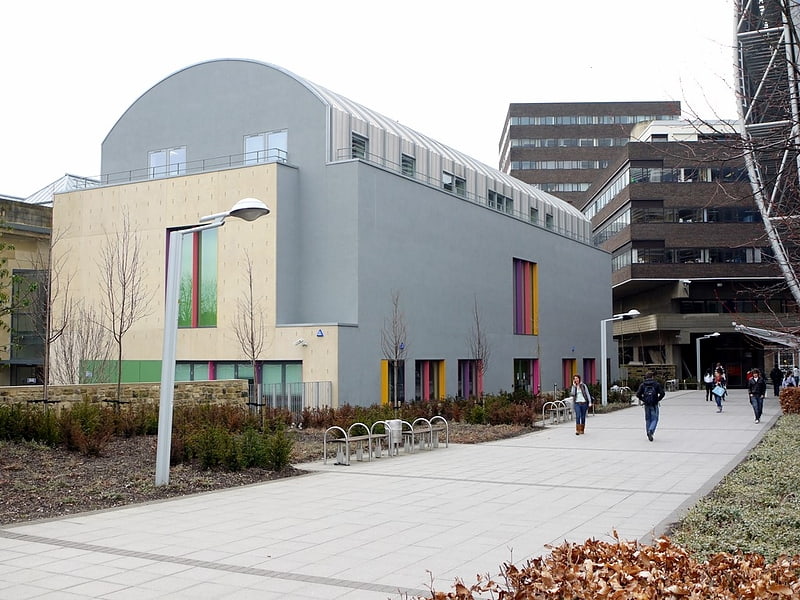
Museum in Newcastle upon Tyne, England. The Great North Museum: Hancock is a museum of natural history and ancient civilisations in Newcastle upon Tyne, England.
The museum was established in 1884 and was formerly known as the Hancock Museum. In 2006 it merged with Newcastle University's Museum of Antiquities and Shefton Museum to form the Great North Museum. The museum reopened as the Great North Museum: Hancock in May 2009 following a major extension and refurbishment of the original Victorian building. The museum and most of its collections are owned by the Natural History Society of Northumbria, and it is managed by Tyne & Wear Archives & Museums on behalf of Newcastle University.[4]
Address: Hancock Museum Great North Road, NE2 4PT Newcastle upon Tyne
Angel Of The North
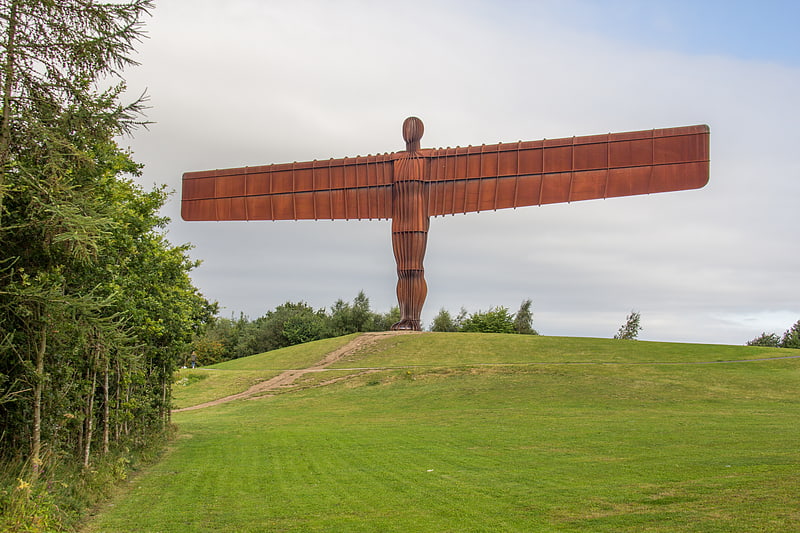
Anthony Gormley's iconic angel statue. The Angel of the North is a contemporary sculpture by Antony Gormley, located in Gateshead, Tyne and Wear, England. Completed in 1998, it is believed to be the largest sculpture of an angel in the world and is viewed by an estimated 33 million people every year due to its proximity to the A1 and A167 roads and the East Coast Main Line. The design of the Angel, like many of Gormley's works, is based on Gormley's own body. The COR-TEN weathering steel material gives the sculpture its distinctive rusty, oxidised colour. It stands 20 metres tall with a wingspan of 54 metres – which is larger than a Boeing 757 aircraft. The vertical ribs on the body and wings of the Angel act as an external skeleton which direct oncoming wind to the sculpture's foundations, allowing it to withstand wind speeds of over 100 miles per hour.
The sculpture was commissioned and delivered by Gateshead Council who approached Gormley to be the sculptor. Although initially reluctant, Gormley agreed to undertake the project after visiting and being inspired by the Angel's proposed site – a former colliery overlooking the varied topography of the Tyne and Wear Lowlands National Character Area.
Hartlepool Steel Fabrications were responsible for the manufacture and assembly of the 200-tonne sculpture. On 14 February 1998, the Angel was transported overnight to the installation site, and the sculpture was erected on the next morning. The Angel of the North faced opposition during its design and construction phases, but is now widely recognised as an iconic example of public art and as a symbol of Gateshead and of the wider North East region.[5]
Address: Durham Road, NE9 6AA Newcastle upon Tyne
Baltic Centre for Contemporary Art
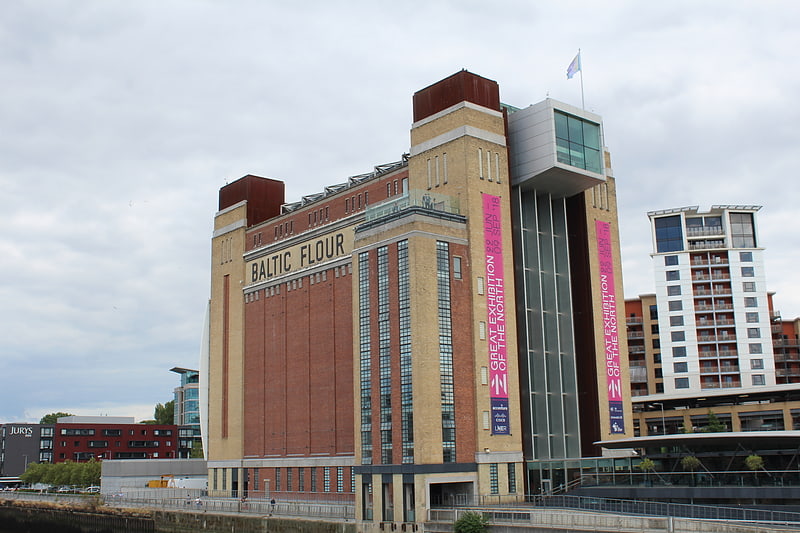
Art center in Gateshead, England. Baltic Centre for Contemporary Art is a centre for contemporary art located on the south bank of the River Tyne in Gateshead, Tyne and Wear, England. It hosts a frequently changing programme of exhibitions, events, and educational programmes with no permanent exhibition. The idea to open a centre for contemporary arts in Gateshead came about in the 1990s, which was a time of regeneration for the local area, with the Sage and Gateshead Millennium Bridge also being conceived of in this period.
Baltic opened in July 2002 in a converted flour mill which had been in operation in various capacities from 1950-1984. The architectural design of Baltic was devised by Dominic Williams of Ellis Williams Architects, who won a competition to design the new contemporary arts centre in 1994. The building features exhibition spaces, a visitor centre, a rooftop restaurant and external viewing platforms which offer views of the River Tyne. Baltic's director is Sarah Munro who joined in November 2015. She is the first woman in its history to hold the position. As of January 2022, Baltic had welcomed over 8 million visitors.[6]
Address: S Shore Rd, NE8 3BA Gateshead
Gateshead Millennium Bridge
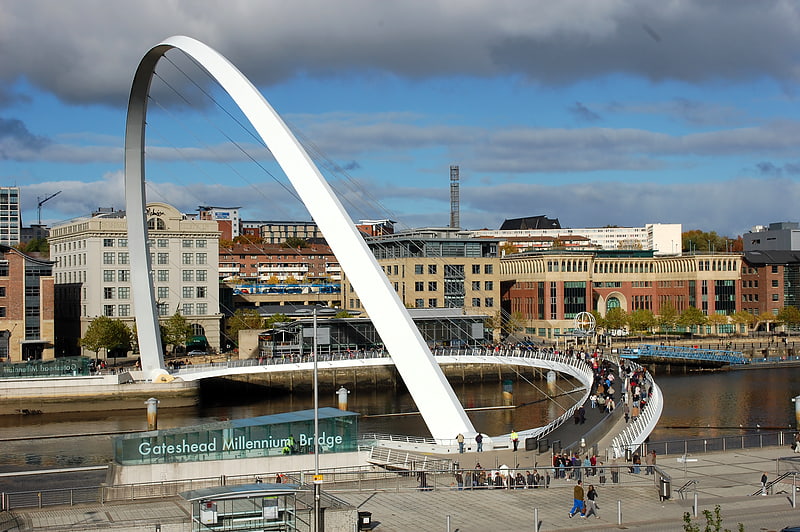
Contemporary pedestrian and cyclist bridge. The Gateshead Millennium Bridge is a pedestrian and cyclist tilt bridge spanning the River Tyne between Gateshead arts quarter on the south bank and Newcastle upon Tyne's Quayside area on the north bank. It was the first tilting bridge ever to be constructed. Opened for public use in 2001, the award-winning structure was conceived and designed by architectural practice WilkinsonEyre and structural engineering firm Gifford. The bridge is sometimes called the 'Blinking Eye Bridge' or the 'Winking Eye Bridge' due to its shape and its tilting method. The Millennium Bridge stands as the twentieth tallest structure in the city, and is shorter in stature than the neighbouring Tyne Bridge.[7]
Address: South Shore Rd, NE8 3AE Gateshead
Sage Gateshead
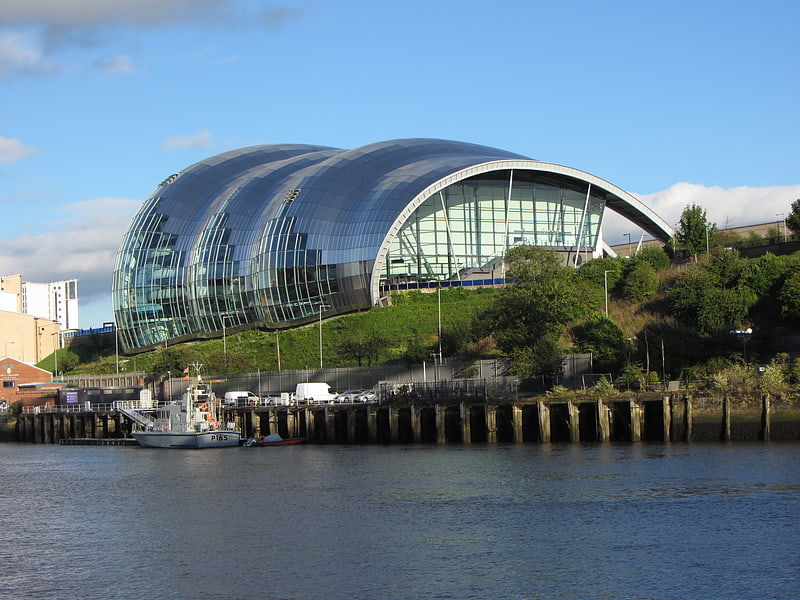
Concert venue in Gateshead, England. Sage Gateshead is a concert venue and also a centre for musical education, located in Gateshead on the south bank of the River Tyne, in North East England. It opened in 2004 and is occupied by North Music Trust.
The venue is part of the Gateshead Quays development, which also includes the Baltic Centre for Contemporary Art and the Gateshead Millennium Bridge.[8]
Address: St. Mary's Sq, NE8 2JR Gateshead
Newcastle Castle
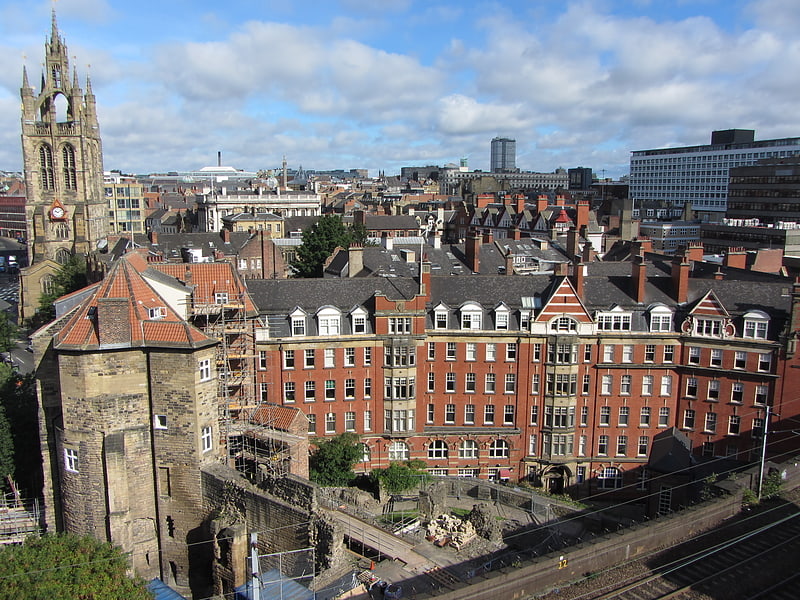
Castle in Newcastle upon Tyne, England. The Castle, Newcastle, or Newcastle Castle is a medieval fortification in Newcastle upon Tyne, England, built on the site of the fortress that gave the City of Newcastle its name. The most prominent remaining structures on the site are the Castle Keep, the castle's main fortified stone tower, and the Black Gate, its fortified gatehouse.
Use of the site for defensive purposes dates from Roman times, when it housed a fort and settlement called Pons Aelius (meaning 'bridge of Hadrian'), guarding a bridge over the River Tyne. Robert Curthose, eldest son of William the Conqueror, in 1080 built a wooden motte and bailey style castle on the site of the Roman fort. Curthose built this 'New Castle upon Tyne' after he returned south from a campaign against Malcolm III of Scotland. Henry II built the stone Castle Keep between 1172 and 1177 on the site of Curthose's castle. Henry III added the Black Gate between 1247 and 1250. Nothing remains of the Roman fort or the original motte and bailey castle. The Keep is a Grade I listed building, and a Scheduled Ancient Monument.
The Castle Keep and Black Gate pre-date the construction of the Newcastle town wall, construction of which started around 1265, and did not include it. The site of the keep is in the centre of Newcastle and lies to the east of Newcastle station. The 75-foot (23 m) gap between the keep and the gatehouse is almost entirely filled by the railway viaduct that carries the East Coast Main Line from Newcastle to Scotland.
The keep and Black Gate are now managed by the Old Newcastle Project under the Heart of the City Partnership as one combined visitor attraction, "Newcastle Castle".[9]
Address: Castle Garth, NE1 1RQ Newcastle upon Tyne
Metro Radio Arena
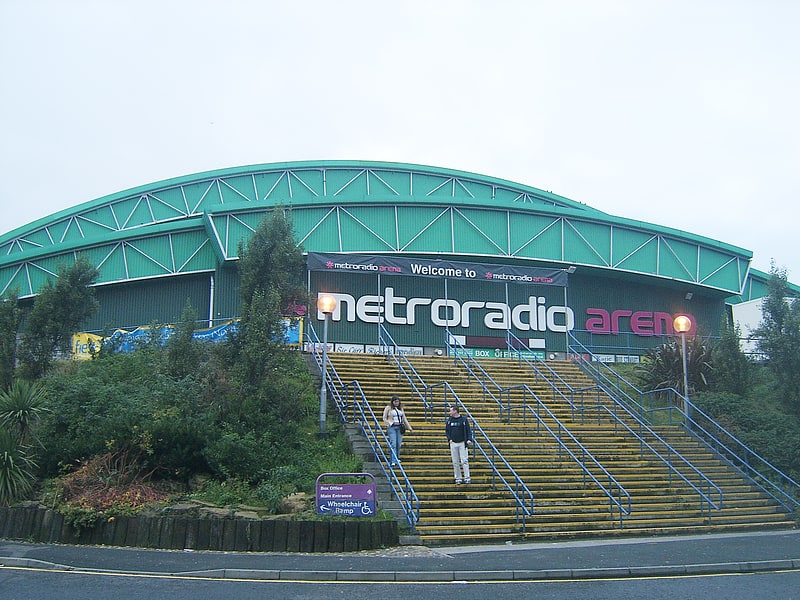
Sports arena in Newcastle upon Tyne, England. Utilita Arena may refer to one of several indoor arenas in the United Kingdom which are, or have been, sponsored by Utilita Energy:
- Utilita Arena Birmingham (2020–)
- Utilita Arena Newcastle (2019–)
- Utilita Arena Sheffield (2021–)
Address: Arena Way, NE4 7NA Newcastle upon Tyne
Saltwell Park
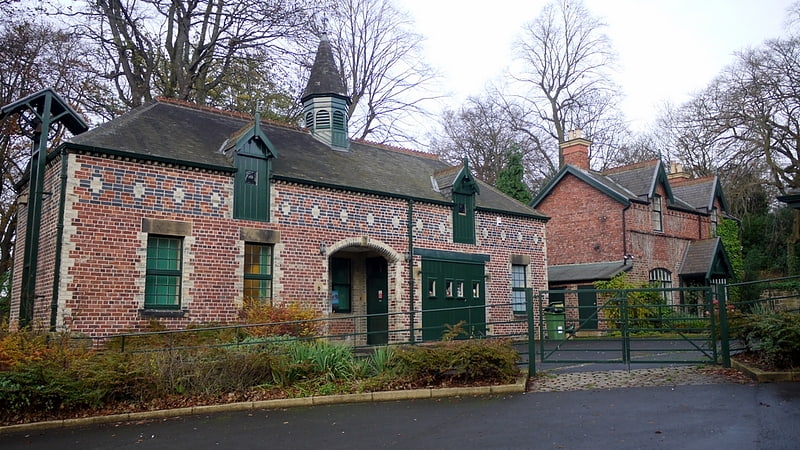
Park in Gateshead, England. Saltwell Park is a Victorian park in Gateshead, Tyne and Wear, England. Opened in 1876, the park was designed by Edward Kemp and incorporates the mansion and associated grounds of the Saltwellgate estate owner, William Wailes, who sold his estate to Gateshead Council for £35,000. Upon opening, it became known as "The People's Park". The park was expanded in 1920 when the council purchased the adjacent gardens to the Saltwell Grove estate and added these to the park. This extended the park's total size to 55 acres. Towards the end of the 20th century, the park had fallen into disrepair, but between 1999 and 2005, it was subject to a £9.6 million restoration project, funded collaboratively by the Heritage Lottery Fund and Gateshead Council and is now host to around 2 million visitors per year.
The park is split broadly into three sections. Saltwell Grove, the southern section, is an area of grassed open space with a bandstand to the western corner. The central area contains the centrepiece of the park – Wailes's former home, the Grade II listed Saltwell Towers and its surrounding belvedere walls. These have been fully restored and are now a visitor centre. There are also three war memorials, a yew-tree maze, a dene and an area containing several species of caged animals known as Pet's Corner. The largest section of the park is the Northern Fields section which contains a four-acre boating lake with a wooded island at its centre, as well as three bowling greens and two pavilions.
Saltwell Park has been presented with numerous awards in recent years, including being named "Britain's Best Park" in 2005 and Civic Trust Park of the Year in 2006. It has won a Green Flag award every year since 2006 and in was 2013 re-listed as one of fifty-five Green Heritage sites in the UK. The park has been a social hub for over a century; an annual public bonfire night display was first held in 1883, a circus in 1886 and the park hosted the Holidays at Home programme during World War II. Today the bonfire display has grown into one of the largest in Tyne and Wear and is attended by thousands of people every year. In October 2012, Saltwell Park was the site of the first British Legion Field of Remembrance in North East England. It also plays a role in local sport and recreation; it has hosted a fundraising day in support of Sport Relief, a Race for Life for a number of years and in November 2012 a "green gym" was installed at the park – one of only two in Gateshead.[11]
Address: E Park Rd, NE9 5AX Gateshead
Newcastle Cathedral

11th-century edifice and an ornate spire. Newcastle Cathedral, formally the Cathedral Church of St Nicholas, is a Church of England cathedral in Newcastle upon Tyne, England. It is the seat of the Bishop of Newcastle and is the mother church of the Diocese of Newcastle, the most northerly diocese of the Anglican Church in England, which reaches from the River Tyne as far north as Berwick-upon-Tweed and as far west as Alston in Cumbria. The cathedral is a grade II* listed building.
Founded in 1091 during the same period as the nearby castle, the Norman church was destroyed by fire in 1216 and the current building was completed in 1350, so is mostly of the Perpendicular style of the 14th century. Its tower is noted for its 15th-century lantern spire. Heavily restored in 1777, the building was raised to cathedral status in 1882, when it became known as the Cathedral Church of St Nicholas.[12]
Address: St. Nicholas Sq, NE1 1PF Newcastle upon Tyne
High Level Bridge
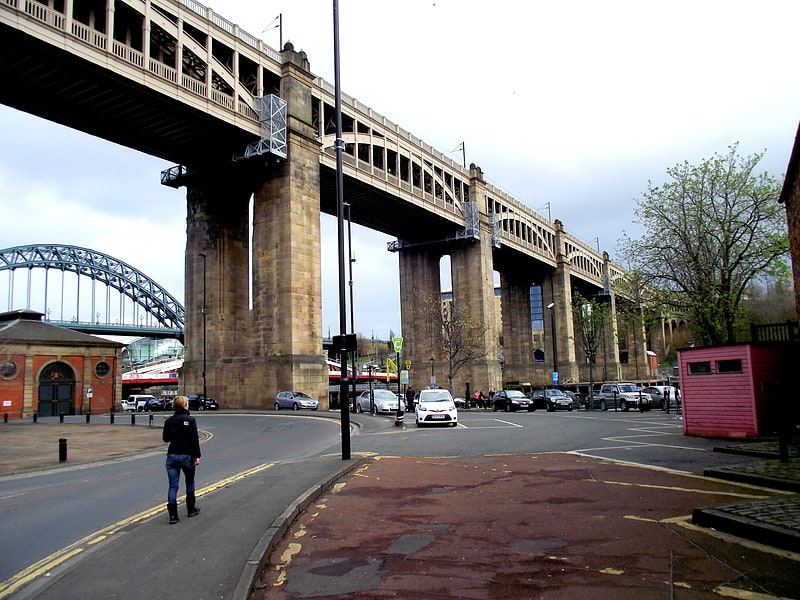
Bridge. The High Level Bridge is a road and railway bridge spanning the River Tyne between Newcastle upon Tyne and Gateshead in North East England. It is considered the most notable historical engineering work in the city. It was built by the Hawks family from 5,050 tons of iron. George Hawks, Mayor of Gateshead, drove in the last key of the structure on 7 June 1849, and the bridge was officially opened by Queen Victoria later that year.
It was designed by Robert Stephenson to form a rail link towards Scotland for the developing English railway network; a carriageway for road vehicles and pedestrians was incorporated to generate additional revenue. The main structural elements are tied cast-iron arches.
Notwithstanding the considerable increase in the weight of railway vehicles since it was designed, it continues to carry rail traffic, although the King Edward bridge nearby was opened in 1906 to ease congestion. The roadway is also still in use, although with a weight restriction. It is a Grade I listed structure.[13]
Address: Newcastle to Gateshead, NE1 Gateshead
Tyne Bridge

Landmark with distinctive architecture. The Tyne Bridge is a through arch bridge over the River Tyne in North East England, linking Newcastle upon Tyne and Gateshead. The bridge was designed by the engineering firm Mott, Hay and Anderson, who later designed the Forth Road Bridge, and was built by Dorman Long and Co. of Middlesbrough. The bridge was officially opened on 10 October 1928 by King George V and has since become a defining symbol of Tyneside. It is ranked as the tenth tallest structure in the city.[14]
Church of St Thomas the Martyr
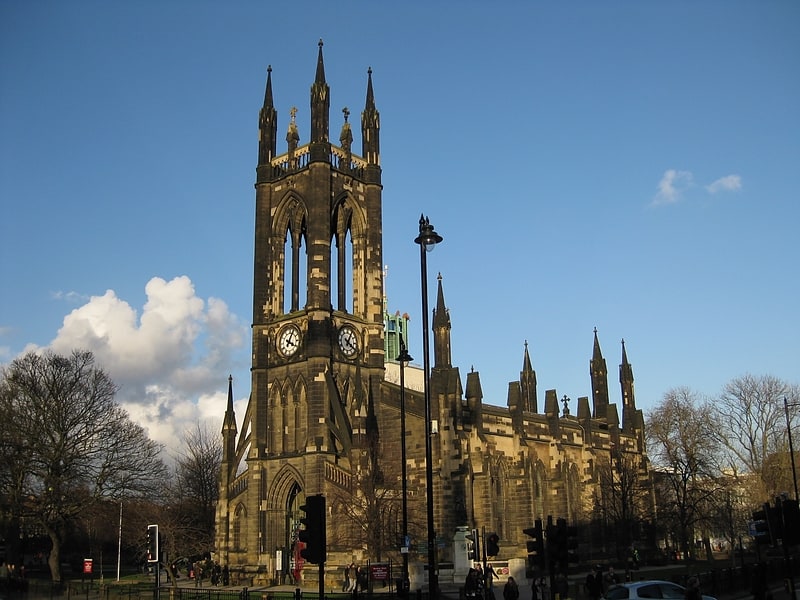
Church in Newcastle upon Tyne, England. The Church of St Thomas the Martyr in Newcastle upon Tyne is one of the most prominent city centre landmarks, located close to both universities, the city hall and main shopping district in the Haymarket. It is a 19th-century Anglican re-foundation of a medieval chapel, traditionally said to have been created by one of the assassins of Thomas Becket. Revitalised and appointed as Resource Church for the Diocese of Newcastle in 2019, with a new minister and staff team, it has now become a popular church for students and young adults.[15]
Address: Haymarket Ln, NE1 7PF Newcastle upon Tyne
Live Theatre
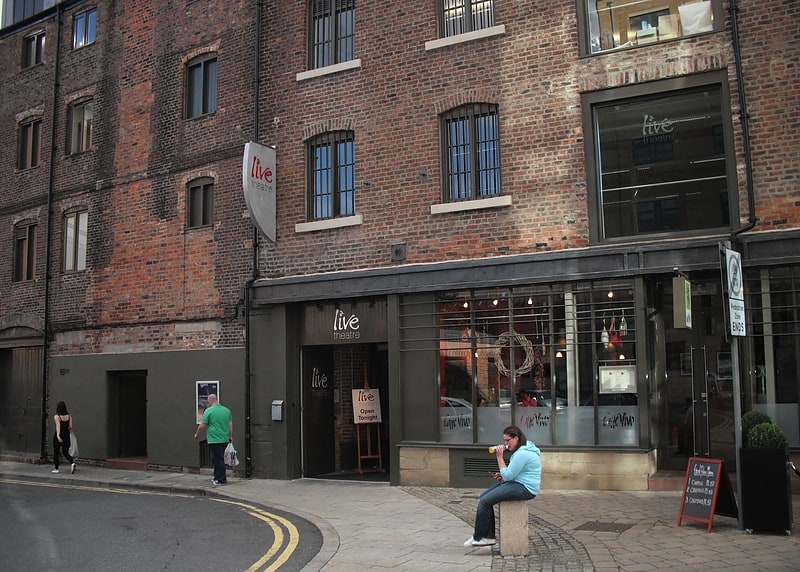
Theatre in Newcastle upon Tyne, England. Live Theatre, formerly Live Theatre Company is a new writing theatre and company based in Newcastle upon Tyne, England. As well as producing and presenting new plays many of which go on to tour nationally and internationally, it seeks out and nurtures creative talent and runs a large education programme for young people.[16]
Address: Newcastle upon Tyne, Broad Chare, Quayside
St Mary's Cathedral
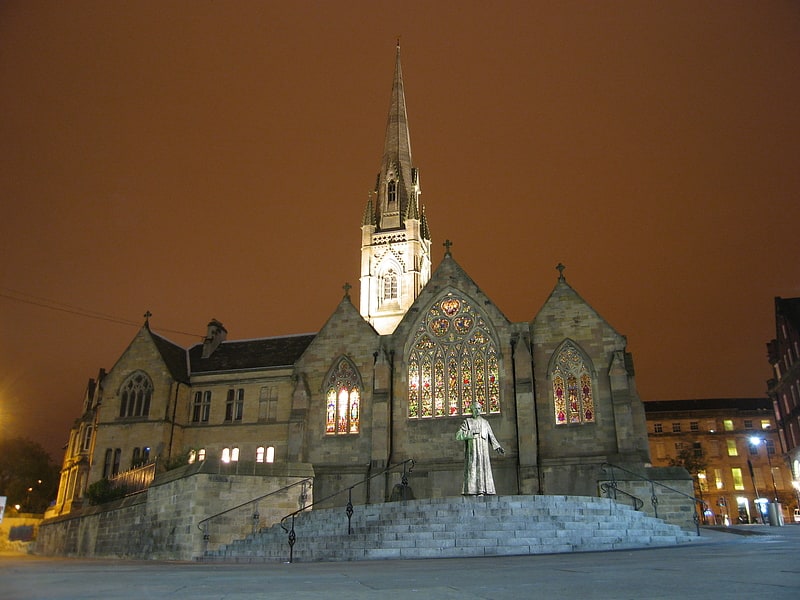
Cathedral with renowned east window. The Cathedral Church of St Mary is a Catholic cathedral in Newcastle upon Tyne, England, the mother church of the Diocese of Hexham and Newcastle and seat of the Bishop of Hexham and Newcastle. The Cathedral, situated on Clayton Street, was designed by Augustus Welby Pugin and built between 1842 and 1844. The cathedral is a grade I listed building and a fine example of the Gothic Revival style of architecture championed by Pugin. There is a monument dedicated to Cardinal Basil Hume in the Monument Garden outside of the cathedral, which was opened by Queen Elizabeth II in 2002. St Mary's Cathedral is the sixth tallest structure in the city.[17]
Address: Clayton St W, NE1 5HH Newcastle upon Tyne
Grey's Monument

Statue by Edward Hodges Baily. Grey's Monument is a Grade I listed monument to Charles Grey, 2nd Earl Grey built in 1838 in the centre of Newcastle upon Tyne, England. It was erected to acclaim Earl Grey for the passing of the Great Reform Act of 1832 and stands at the head of Grey Street. It consists of a statue of Lord Grey standing atop a Roman Doric column on a pedestal of local sandstone, 135-foot-high in total. The column was designed by local architects John and Benjamin Green, and the statue was created by the sculptor Edward Hodges Baily. It was paid for by public subscription.
In July 1941, during World War II, the head of the statue was knocked off by a bolt of lightning. In 1947, sculptor Roger Hedley (the son of painter Ralph Hedley) created a new head based on the preserved fragments of the original.
The monument lends its name to Monument Metro station, a station on the Tyne and Wear Metro located directly underneath, to the Monument Mall Shopping Centre and to the Monument local authority ward. The surrounding area is simply known as Monument.
A spiral staircase leads to a viewing platform at the top of the monument, which is occasionally opened to the public. Old photographs indicate that the monument was originally on a traffic island and was surrounded by railings. These railings are no longer present, and the area around the monument is now pedestrianised and is home to many shops, some independent and some up-scale designer boutiques.
The wide base of the monument is a popular spot for people-watching, and often acts as a venue for buskers, religious speakers and political activists/protesters. The Maxïmo Park song By the Monument refers to Grey's Monument and the line "By the monument you hear, man is screaming through a megaphone;'Get your hands off the Middle East'" in the song Play God by Sam Fender is an apparent reference to Grey's Monument.
The Monument is in the Monument electoral ward of the City of Newcastle upon Tyne, and the parliamentary constituency of Newcastle upon Tyne Central.[18]
Address: Blackett St., NE1 7AL Newcastle upon Tyne
Holy Jesus Hospital
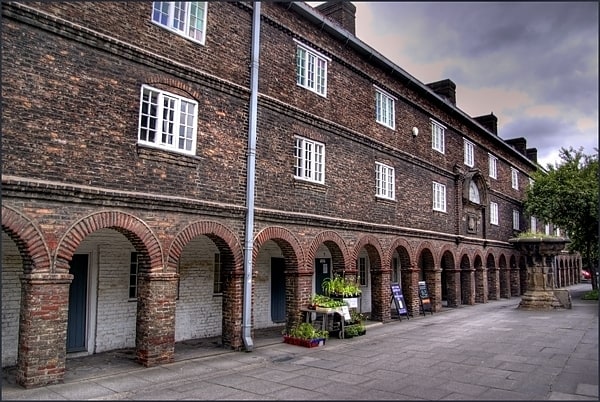
Tourist attraction in Newcastle upon Tyne, England. The Holy Jesus Hospital is a working office in Newcastle upon Tyne, England, in the care of the National Trust. It is a Grade II* listed building.
The site of the hospital has been in use for 700 years helping the townspeople. There was an Augustinian friary on the site from the thirteenth century, then an almshouse for housing retired freemen, then a soup kitchen was built next to Almshouse in the nineteenth century, before the site acquired its current function as a working office. The building also serves as the basis of the Inner City Project of the National Trust. This project takes people of ages 12–25 and over 50 out to the countryside in order to increase appreciation of the city's natural surroundings.
The building is of architectural interest because it still retains architectural elements from many previous centuries, including a 14th-century sacristy wall and 16th-century tower connected with the King's Council of the North. It is also one of only two intact 17th-century brick buildings that survive in the city, the other being Alderman Fenwick's House.[19]
Address: Holy Jesus Hospital City Road, NE1 2AS Newcastle upon Tyne
Swing Bridge

Swing bridge in the United Kingdom. The Swing Bridge is a swing bridge over the River Tyne, England, connecting Newcastle upon Tyne and Gateshead, and lying between the Tyne Bridge and the High Level Bridge. It is a Grade II* listed structure.[20]
Tyneside Cinema
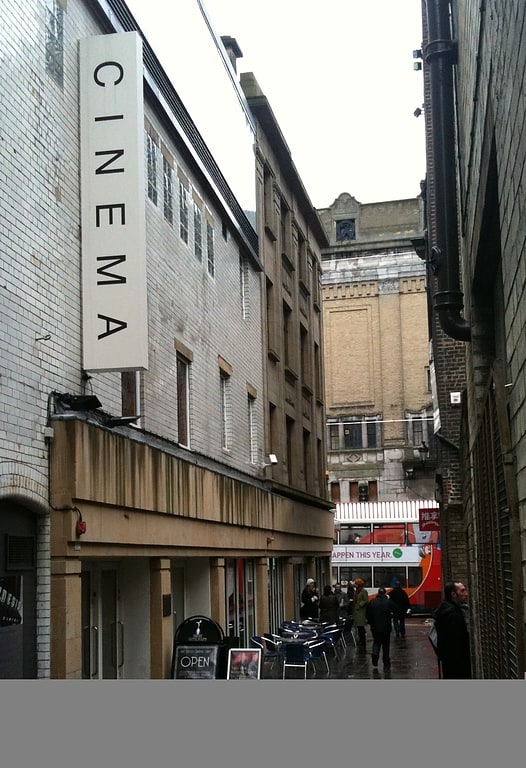
Building in Newcastle upon Tyne, England. The Tyneside Cinema is an independent cinema in Newcastle upon Tyne. It is the city's only full-time independent cultural cinema, specialising in the screening of independent and world cinema from across the globe. The last remaining Newsreel theatre to be in full-time operation in the UK, it is a Grade II-listed building. The Tyneside's patrons are filmmakers Mike Figgis and Mike Hodges, and musicians Neil Tennant of the Pet Shop Boys and Paul Smith of Maxïmo Park. Its cultural remit is set by the trustees and is a requisite for continued funding from sponsors such as the BFI and the Arts Council.
Alongside its core programme of cultural cinema, the newly refurbished Tyneside Cinema holds daily free screenings of archive newsreel footage and guided tours. The cinema also allows budding producers and digital artists to network and present their work. A £7m restoration and renovation project occurred between 2006 and 2008, and the venue now boasts digital projection and 3D facilities alongside traditional film projection.[21]
Address: Newcastle upon Tyne, Pilgrim Street, Newcastle upon Tyne, United Kingdom
Theatre Royal
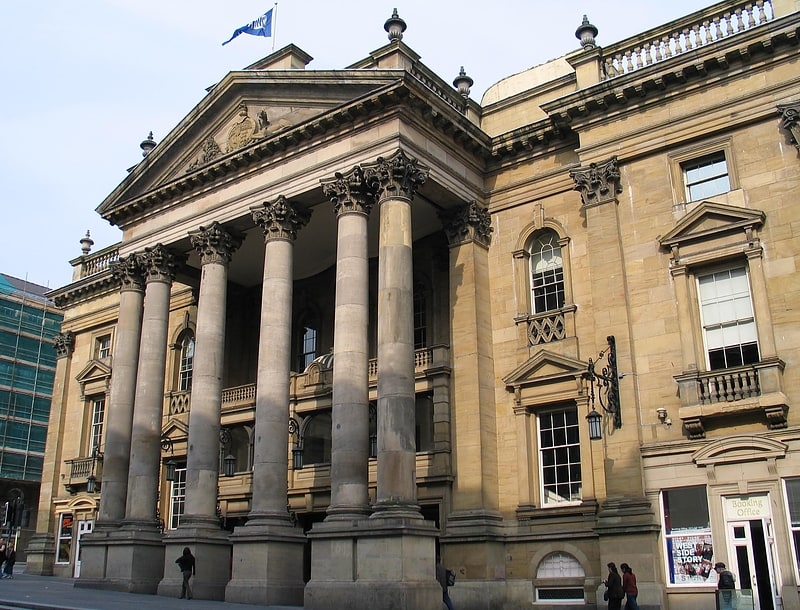
Theatre in Newcastle upon Tyne, England. The Theatre Royal is a historic theatre, a Grade I listed building situated on Grey Street in Newcastle upon Tyne.[22]
Address: Newcastle upon Tyne, Grey Street
St Peter's Church

Church in Wallsend, England. The Church of St Peter is a Church of England Grade II* listed church located on the east side of Wallsend, North Tyneside. It was constructed to replace Holy Cross Church, which had been built c. 1150 but had fallen into disrepair by the end of the eighteenth century. The building was extensively remodeled in 1892 in the Perpendicular style to give it its present form. The parish church oldest in Wallsend[23]
Address: Church Bank, NE28 7LH Wallsend
Gateshead International Stadium

Multi-purpose stadium in Gateshead, England. Gateshead International Stadium is a multi-purpose, all-seater venue in Gateshead, Tyne and Wear, England. Originally known as the Gateshead Youth Stadium, the venue was built in 1955 at a cost of £30,000. It has since been extensively re-developed on three occasions. Its capacity of around 11,800 is the greatest in the Metropolitan Borough of Gateshead, the third-largest in Tyne and Wear, and the sixth-largest in North East England.
The main arena is principally used for athletics. The inaugural athletics competition at the redeveloped venue, the 1974 "Gateshead Games", was instigated by Brendan Foster, a Gateshead Council employee at that time. By breaking the world record in the men's 3,000 m, Foster brought international publicity to the new stadium and began a tradition of athletics competitions at the venue, which has since hosted the British Grand Prix (2003–10) and the European Team Championships in 1989, 2000 and 2013. It is the only venue to have hosted the latter event three times. Five world records have been set at the stadium, including two by pole vaulter Yelena Isinbayeva and a tied 100 metres record by Asafa Powell in 2006.
Although the venue primarily caters for athletics, it is the current or former home to teams in several sports. It has been used by the town's main football club since 1973. Gateshead International Stadium was home to the Gateshead Thunder rugby league club during their spell in the Super League and the replacement Gateshead Thunder club played home games in the main arena, which was known as the Thunderdome when used by that team until the club relocated to Newcastle in 2015. Gateshead Harriers Athletic Club, which includes Foster and Jonathan Edwards among its life members, are the oldest tenants, having used the site since 1956. The stadium has also been used as a concert venue by numerous musical artists including Little Mix, Guns N' Roses, Bon Jovi, Bryan Adams and Tina Turner.[24]
Address: Marigold Ave, NE10 0DP Gateshead
Leazes Park Synagogue
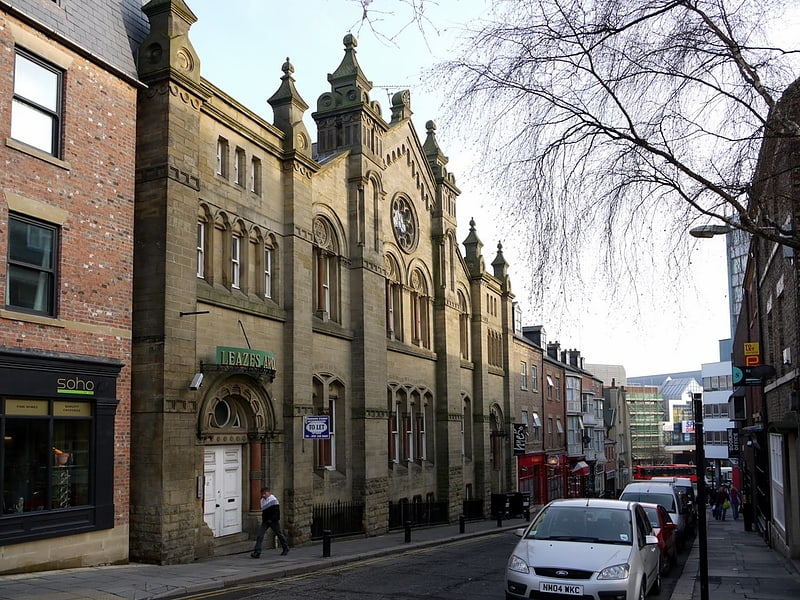
The Leazes Park Synagogue is a former synagogue in Leazes Park Road, Newcastle upon Tyne, England.
The building was designed in 1880 by Scottish architect John Johnstone, who was also responsible for Newcastle's old town hall. It is a grade II listed building, whose elaborate two-storey sandstone frontage was designed in the North Italian style.
The Newcastle Old Hebrew Congregation traces its roots back to 1838 and the founding of Temple Street Synagogue, which merged with the Charlotte Square Synagogue to form the Newcastle United Hebrew Congregation. The amalgamated congregation moved into the new synagogue on Leazes Park Road, which was consecrated on 25 August 1880. There were further mergers in 1924 and 1973, but the Leazes Park Synagogue continued to serve as one of the synagogues of the united congregation until its final closure service on 3 May 1978. The Culzean Park Synagogue in Gosforth is now Newcastle's only active Orthodox synagogue.
The synagogue was extended in the 1920s. The synagogue had a basement schoolroom and a Jewish Sports club was formed there in 1934.
The Leazes Park Synagogue building was put to use as a shopping arcade until a fire destroyed the interior in 1989. Restoration was completed by 1996 and it is now used for student accommodation.[25]
Leazes Park

Park in Newcastle upon Tyne, England. Leazes Park is a Grade II listed park urban park in Newcastle upon Tyne, England. It is the city's oldest park, opened in 1873, and lies to the west of the city centre. The park contains a lake above the course of the Lort Burn. It is next to St James' Park and the Royal Victoria Infirmary.
Leazes Park is separated from Spital Tongues by Castle Leazes, an area of common land similar to the Town Moor.[26]
Address: Richardson Rd, NE1 4LR Newcastle upon Tyne
O2 Academy Newcastle

Music venue in Newcastle upon Tyne, England. The O2 Academy Newcastle is a music venue in Newcastle upon Tyne, England. It opened on 14 October 2005 as the Carling Academy, and was renamed for Telefónica Europe's O2 mobile network brand in 2008. The venue is operated by Academy Music Group.
The O2 Academy has two rooms and can host up to 2,000 people for a show. Major bands and solo musicians that have performed in the main room since 2005 include Arctic Monkeys, Adele, Katy Perry, The Libertines, Sam Smith, McFly, Blondie and Amy Winehouse. The upstairs room, officially known as O2 Academy2, is smaller and hosts performances by lesser-known bands. The venue has also hosted club nights, including Dirty Pop, Ikon Live and Alpha.[27]
Address: Newcastle upon Tyne, Westgate Road, Newcastle upon Tyne, Tyne and Wear, NE1 1SW
Shipley Art Gallery
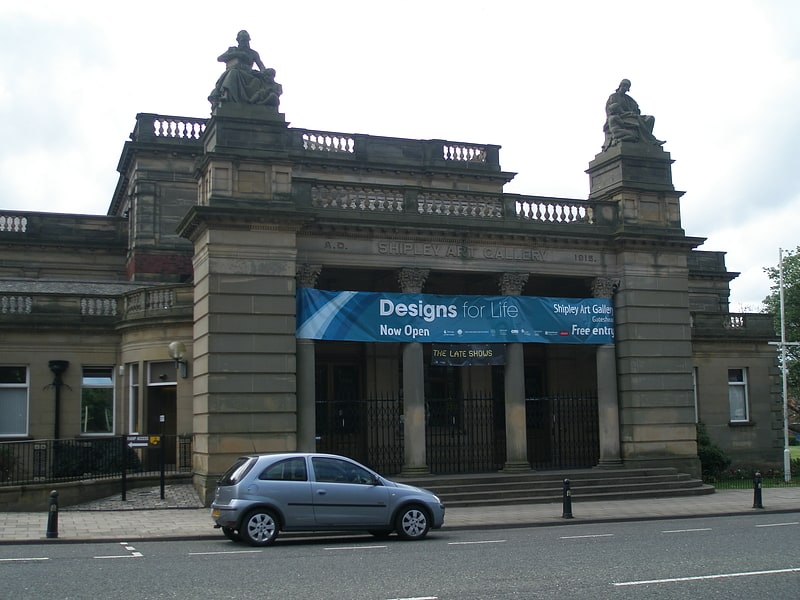
Art gallery in Gateshead, England. The Shipley Art Gallery is an art gallery in Gateshead, Tyne and Wear, England, located at the south end of Prince Consort Road. It has a Designated Collection of national importance.[28]
Address: Prince Consort Rd, NE8 4JB Gateshead
Queen Elizabeth II Bridge
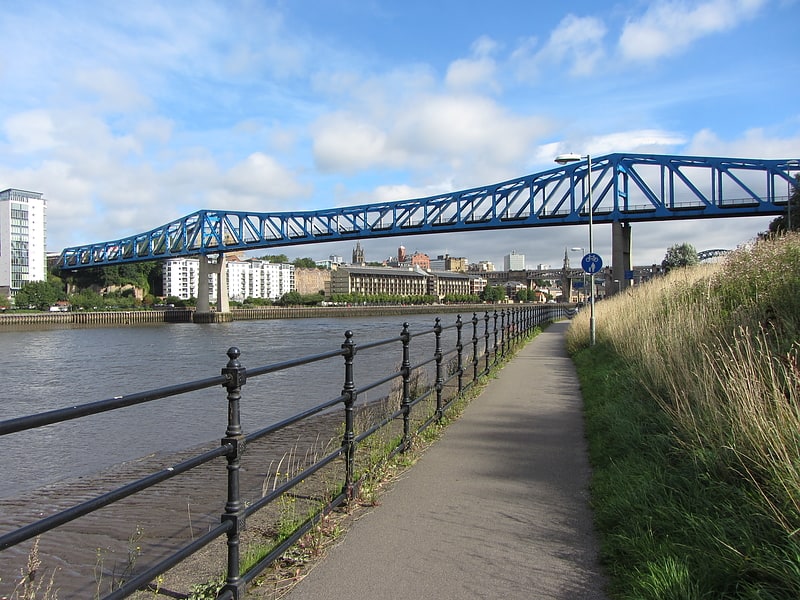
Bridge in England. The Queen Elizabeth II Bridge carries the Tyne and Wear Metro between Newcastle upon Tyne and Gateshead over the River Tyne in North East England. The line is in tunnels on either side of the river and only emerges into open air to cross the bridge.[29]
Redheugh Bridge
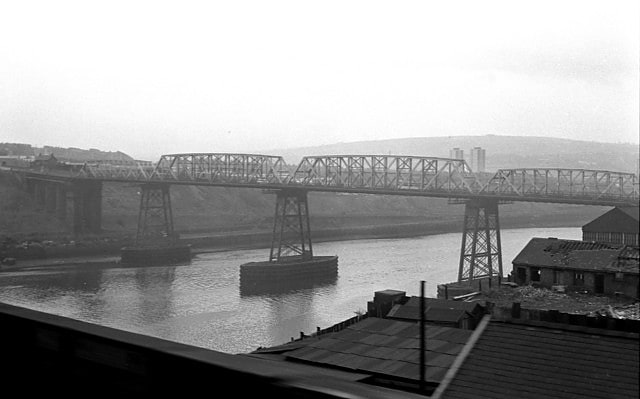
Bridge in Gateshead, United Kingdom. The Redheugh Bridge is a road bridge spanning the River Tyne west of Newcastle upon Tyne city centre on the north bank and Gateshead town centre on the south bank, in North East England. It currently carries the A189 road.[30]
Laing Art Gallery
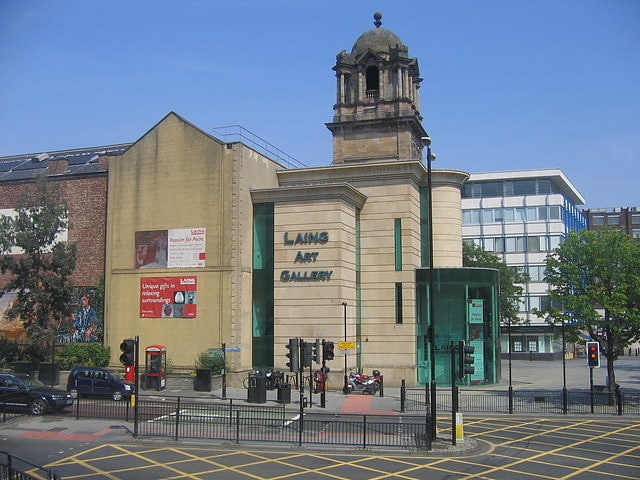
Art gallery in Newcastle upon Tyne, England. The Laing Art Gallery in Newcastle upon Tyne, England, is located on New Bridge Street. The gallery was designed in the Baroque style with Art Nouveau elements by architects Cackett & Burns Dick and is now a Grade II listed building. It was opened in 1904 and is now managed by Tyne & Wear Archives & Museums and sponsored by the Department for Culture, Media and Sport. In front of the gallery is the Blue Carpet. The building, which was financed by a gift from a local wine merchant, Alexander Laing, is Grade II listed.
The gallery collection contains paintings, watercolours and decorative historical objects, including Newcastle silver. In the early 1880s, Newcastle was a major glass producer in the world and enamelled glasses by William Beilby are on view along with ceramics (including Maling pottery), and diverse contemporary works by emerging UK artists. It has a programme of regularly rotating exhibitions and has free entry.
The gallery's collection of seminal paintings includes John Martin's dramatic The Destruction of Sodom and Gomorrah, as well as important works by Sir Joshua Reynolds, Edward Burne-Jones (Laus Veneris), Isabella and the Pot of Basil from 1868 by William Holman Hunt, and Ben Nicholson. Local paintings include pictures by Ralph Hedley. There is also an extensive collection of 18th- and 19th-century watercolours and drawings, including work by J. M. W. Turner and John Sell Cotman.[31]
Address: New Bridge St, NE1 8AG Newcastle upon Tyne
Bessie Surtees House
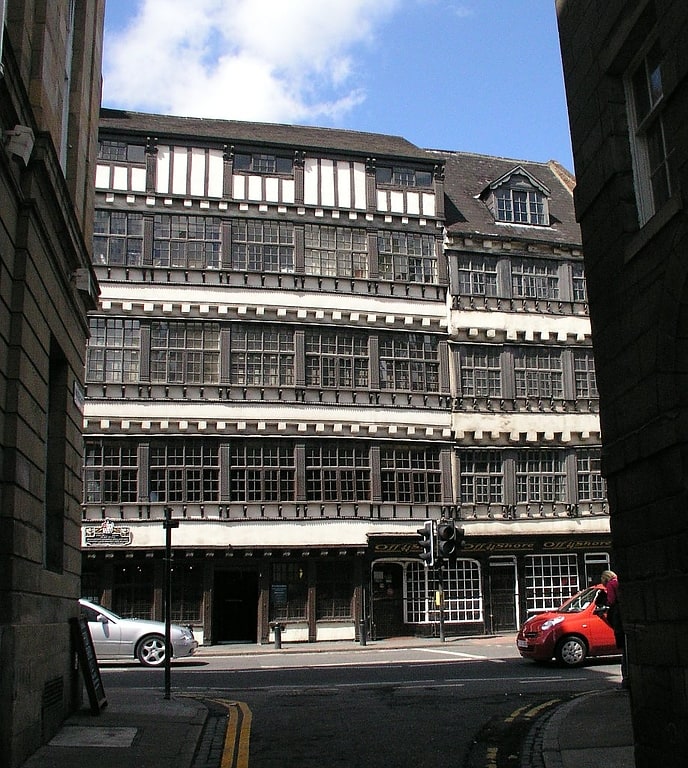
Building in Newcastle upon Tyne, England. Bessie Surtees House is the name of two merchants' houses on Newcastle's Sandhill, near to the river, that were built in the 16th and 17th centuries. The buildings are a fine and rare example of Jacobean domestic architecture. An exhibition detailing the history of the buildings can be found on the first floor. The site is also home to the North East regional branch of English Heritage and Historic England. It is a Grade I listed building.
The house is best known as the scene of the elopement of Bessie Surtees and John Scott, who later became Lord Chancellor. It was restored in 1930 by SR Vereker, later Lord Gort, who employed an engineer to install 17th-century fixtures taken from properties about to be demolished. Newcastle City Council purchased the house in 1978. They leased it to English Heritage in 1989.
In July 2009 it was targeted by graffiti vandals who extensively spray-painted the roof with the tags "LG", "GRIM" and "KAME".[32]
Address: 41-44 Sandhill, NE1 3JF Newcastle Upon Tyne
St Andrew's Church
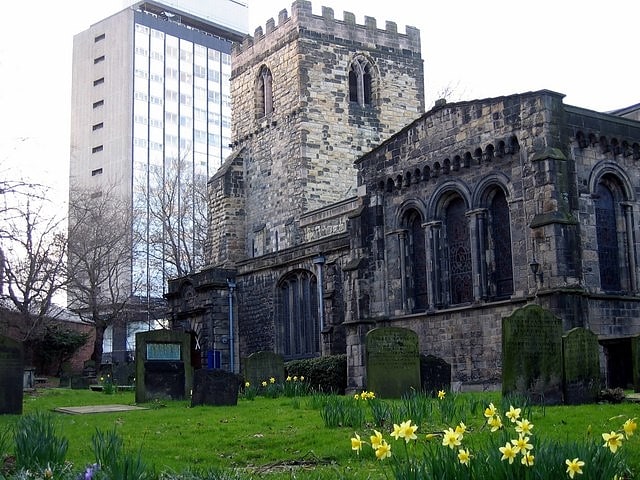
Church in Newcastle upon Tyne, England. St Andrew's Church, Newcastle upon Tyne is a Grade I listed parish church in the Church of England in Newcastle upon Tyne.[33]
Address: Newgate St, NE1 5SS Newcastle upon Tyne
North Tyneside Steam Railway

Museum in the United Kingdom. The North Tyneside Steam Railway and Stephenson Steam Railway are visitor attractions in North Tyneside, North East England. The museum and railway workshops share a building on Middle Engine Lane adjacent to the Silverlink Retail Park. The railway is a standard gauge line, running south for 2 miles from the museum to Percy Main. The railway is operated by the North Tyneside Steam Railway Association. The museum is managed by Tyne and Wear Archives and Museums on behalf of North Tyneside Council.
The railway runs along the alignment of various former coal wagonways, which were later used by the Tyne and Wear Metro Test Centre; the museum and workshop building used to be the test facility. The museum is dedicated to the railway pioneers George Stephenson and his son Robert, with one of George's early locomotives, Billy, housed in the museum.[34]
Address: Middle Engine Lane, Newcastle upon Tyne
People's Theatre
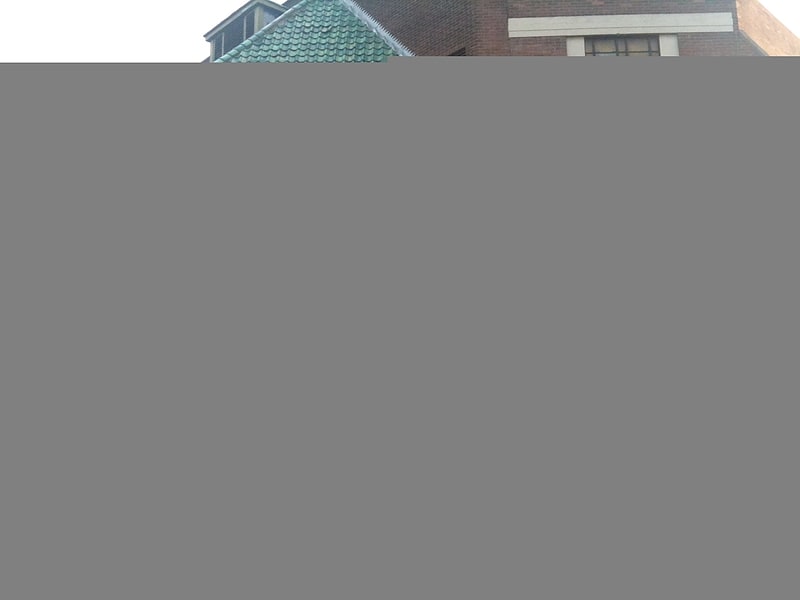
Theatre in Newcastle upon Tyne, England. The People's Theatre is an amateur theatre in Newcastle upon Tyne, England. Originally located in the city centre, the People's Theatre moved to its current site, adjacent to the Coast Road in Heaton, in 1962. It shows approximately 13 productions a year including a full-scale family pantomime.[35]
Address: Newcastle upon Tyne, Stephenson Road, Heaton, Newcastle upon Tyne, NE6 5QF